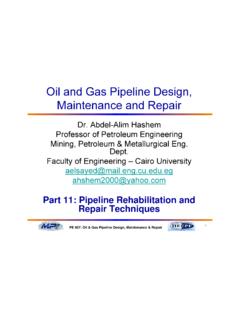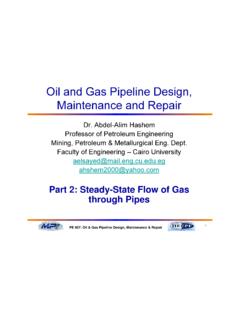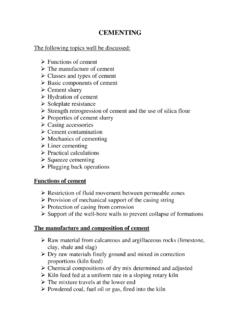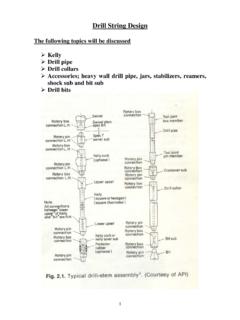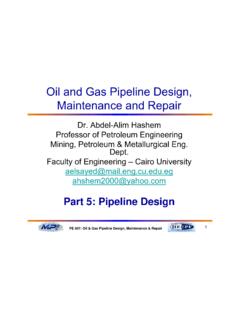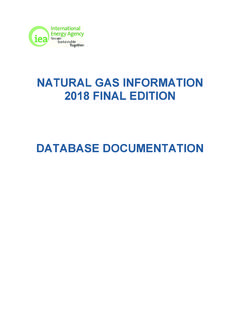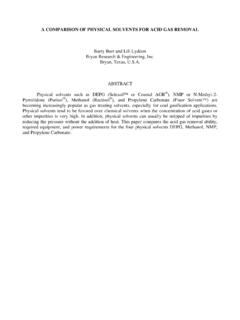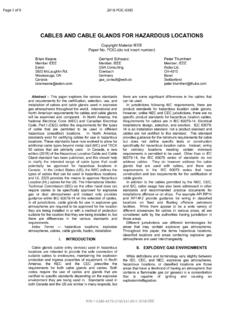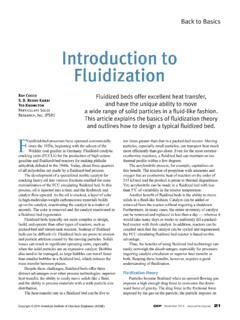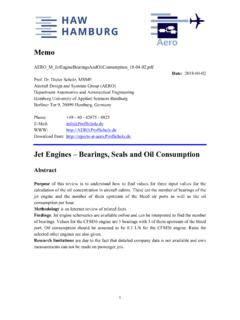Transcription of Oil and Gas Pipeline Design, Maintenance and Repair
1 1PE 607: Oil & Gas Pipeline Design, Maintenance & RepairDr. Abdel-Alim HashemProfessor of Petroleum Engineering Mining, Petroleum & Metallurgical Eng. Dept. Faculty of Engineering Cairo University 6: Planning and Construction of Pipeline oil and gas Pipeline Design, Maintenance and Repair2PE 607: Oil & Gas Pipeline Design, Maintenance & RepairCONTENTS Horizontal Directional Drilling (HOD) Pipe Jacking, Tunneling, Comments on Trenchless Construction, Pipeline Construction in Marsh and Swamp Offshore Construction Cold-Region Construction Freezing Temperature Variation Environmental Concerns Other Considerations Procedures Involved in Planning and Construction of New Pipelines Measures to Allow Pipeline Expansion Bending of Pipes Connecting Pipes Flanges (Joints) Other Mechanical Joints Welding, Boring and Tunneling to Install Pipe - TrenchlessTechnologies Horizontal Earth Boring Horizontal Auger Boring Microtunneling3PE 607.
2 Oil & Gas Pipeline Design, Maintenance & RepairPROCEDURES OF PLANNING AND CONSTRUCTION Planning and construction of any new Pipeline system depends on several factors Material (fluid or solid) to be transported by the Pipeline (whether it is natural gas, oil, water, sewage, slurry or capsules), Length of the Pipeline Environment (whether the Pipeline is in an urban or countryside setting, on land or offshore, worm climate or cold climate More similarities than dissimilarities in constructing differenttypes of pipelines Once a person understands how a given type of Pipeline is built,it is not difficult to figure out how another type should be built. 4PE 607: Oil & Gas Pipeline Design, Maintenance & RepairPROCEDURES OF PLANNING AND CONSTRUCTIONP rocedures used for long-distance steel gas or oil pipelines Step 1: Preliminary planning Step 2: Route selection Step 3: Acquisition of right-of-way Step 4: Soil borings, testing of soil and other data collection Step 5: Pipeline design Step 6: Seek legal permits Step 7: Start construction 1.)
3 Right-or-way preparation2. Stringing5PE 607: Oil & Gas Pipeline Design, Maintenance & RepairPROCEDURES OF PLANNING AND CONSTRUCTION3. Ditching and trenching 4. Boring 5. Tunneling 6. River crossing 7. Welding, coating, and wrapping 8. Pipe laying 9. Backfill and restoration of land For a long Pipeline , the foregoing procedure is applied to a portion of the Pipeline (say. a few miles) at a time After the portion is completed, the same procedure is applied to the next portion. 6PE 607: Oil & Gas Pipeline Design, Maintenance & RepairMEASURES TO ALLOW Pipeline EXPANSION Places affected by thermal expansion, earthquake, soil settlement, etc., allow pipelines to expand (elongate) freely in order to prevent development of large stresses in the pipe. This is especially true for PVC pipes and concrete pipes, which expand several times more than steel pipes due to temperature change. Even for steel pipes that are aboveground, allowance must be made for expansion and shrinkage caused by seasonal weather change Build a zigzagged instead of straight Pipeline to provide allowance for thermal expansion or shrinkage Zigzags move freely either outward (during expansion) or inward (during shrinkage).
4 7PE 607: Oil & Gas Pipeline Design, Maintenance & RepairMEASURES TO ALLOW Pipeline EXPANSION This is common for both aboveground and underground pipelines. For pipelines above ground, sometimes an inverted U or loop is used instead. Special joints are available for expansion Bell-and-spigot joints Slip joints, swivel joints Certain mechanical joints. For small diameter pipe, using a joint made of flexible pipe (hose) will allow 607: Oil & Gas Pipeline Design, Maintenance & RepairBENDING OF PIPES Pipes bent to follow sudden grade changes, or change in the horizontal direction of the Pipeline done conveniently in the field (outdoors) by using a cold bending method Hot bending, produces better results, more cumbersome and costly Done in shops rather than in the field When a pipe is bent, cross section of the pipe deformed from a circular to an oval shape, the thickness of the pipe wall on the outer side of the bend is also reduced due to stretching This is called thinning9PE 607: Oil & Gas Pipeline Design, Maintenance & RepairSHOP HOT BENDINGC ourtesy Tulsa Tube Bending Company 10PE 607.
5 Oil & Gas Pipeline Design, Maintenance & RepairBENDING METHODS FOR STEEL PIPE Compression bending- pressing a pipe with a moving roller against and around a stationary die Draw bending- similar to compression bending except that a mandrel is inserted through one end of the pipe. Ram bending- A ram (punch) with a hemispherical head is pressed against one side of a pipe supported at two neighboring points by two pivoted blocks, rollers, or clamps Internal roll bender (Rotoform) - A French machine that uses a rolling head rotating inside a pipe. Induction bending - pipe passes through a special section at which a strong magnetic held is generated to heat the pipe locally. 11PE 607: Oil & Gas Pipeline Design, Maintenance & RepairCompression Bending12PE 607: Oil & Gas Pipeline Design, Maintenance & RepairDraw Bending13PE 607: Oil & Gas Pipeline Design, Maintenance & RepairRam Bending14PE 607: Oil & Gas Pipeline Design, Maintenance & RepairInduction-bending MachineCourtesy of Tulsa Tube Bending Company15PE 607: Oil & Gas Pipeline Design, Maintenance & RepairCONNECTING PIPES Pipes available in sections or segments* of 20-ft length.
6 For steel pipes, the maximum section length is usually 40 ft. Segments transported to the construction site Before being laid in ditches, sections joined (connected) together to form a long Pipeline Joining can be done in several ways including Flanged joints Other mechanical joints Welding 16PE 607: Oil & Gas Pipeline Design, Maintenance & RepairLong Distance Pipe17PE 607: Oil & Gas Pipeline Design, Maintenance & RepairDitchingough3 607: Oil & Gas Pipeline Design, Maintenance & RepairWelding A 24-in Steel Pipe Using an Electric Arc and an Internal Lineup Damp19PE 607: Oil & Gas Pipeline Design, Maintenance & RepairPipeline Welding Defects Under cutting Due to technique mistakes Accumulation of discontinuity Long time interval between the welding path Cracks Shrinkage of metal due metallurgical errors Porosity or gas pockets Resulting of the welding metals metallurgical properties20PE 607.
7 Oil & Gas Pipeline Design, Maintenance & RepairPipeline Welding Defects Slag inclusion Existence of non-metallic material between the welding and the pipe metal Burn through ) ( Error in welding material selection Incomplete fusion Fast welding movement Dirty pipe surface Existence of gas between welding and pipe Inadequate penetration Incomplete bevel ends Fast welding movement21PE 607: Oil & Gas Pipeline Design, Maintenance & RepairWelding Inspection and Testing There are two inspection methods: Non-destructive test (NDT) Visual inspection (not accurate) Radiographic (x-ray or gamma ray) Destructive test (DT) This could be done by taking a sample of the welding part and test it in the lab Location of the sample should be according to API standard The tests could be tension, bending and impact22PE 607: Oil & Gas Pipeline Design, Maintenance & RepairBORING AND TUNNELING -TRENCHLESS TECHNOLOGIES To minimize construction costs, the open-cut (ditching and trenching) method to lay pipe Generally used in rural and remote locations Exception crossing rivers, lakes, roads, and other obstacles Crossing such obstacles, other alternatives as Rerouting the Pipeline , Using or building a bridge (for river crossing) Underground construction boring and tunneling23PE 607: Oil & Gas Pipeline Design, Maintenance & RepairHorizontal Earth Boring (HEB) Uses a machine that bores a horizontal or nearly horizontal hole (small tunnel) underground for laying pipes beneath obstacles such as a roadway.
8 The boring and subsequent installation of pipes is done by a machine without workers being present in the borehole. Three types of HEB Horizontal auger boring Micro-tunneling Horizontal directional drilling24PE 607: Oil & Gas Pipeline Design, Maintenance & RepairHorizontal Auger Boring Components of horizontal auger boring (HAB) include a cutting head, a set of cutters mounted on the front face of the boring machine, cut earth by the rotation of the cutters an auger: front end connected to the cutting head and tail end connected to the prime mover that drives the system, to convey the spoil ( , the earth or rock that has been cut loose) to outside the borehole: a nonrotating casing around the rotating auger, which is the pipe to be installed a prime mover that provides the torque to rotate the auger and the cutters and provides the thrust to advance the pipe (casing) along with the cutting head and the auger; 25PE 607: Oil & Gas Pipeline Design, Maintenance & RepairHorizontal Auger Boring a system to inject bentonite slurry around the pipe to reduce friction between the pipe and the surrounding earth in order to facilitate the advancement of the pipe during the action of boring; a system to receive, store, process, and recycle the bentonite slurry control and monitoring equipment.
9 The entire boring system is controlled from outside the borehole, and no human needs to be present inside the borehole or pipe The system can lay pipes of diameters as small as a few inches. and as large as several feet. 26PE 607: Oil & Gas Pipeline Design, Maintenance & RepairA Horizontal Earth-boring MachineCourtesy Herenknecht Company and Ruhe-University of Bochum, Germany 27PE 607: Oil & Gas Pipeline Design, Maintenance & RepairMicrotunneling Microtunneling is the high-tech version of the horizontal earth-boring system Invented and first used in Japan in the 1970s. Uses a laser-guided and remote-controlled pipe jacking system Permits accurate monitoring and control of the horizontal direction and the grade of the pipe Because no human entry into the pipe or tunnel is needed, the technology is applicable to small as well as large pipes Used most for installing pipes of less than 1m diameter The system is rather 607: Oil & Gas Pipeline Design, Maintenance & RepairMicrotunneling Applicable to all types of soil, and a large variety of depths (up to about 50 m below ground), either above or below groundwater table.
10 Best suited for installing sewer pipes, which normally require accurate grade and alignment. One of two methods is used to remove the cut materials (spoil) from the pipe. The first method uses an auger. The second method involves using slurry to mix with the spoil for hydraulic removal by pipes. The slurry facilitates cutting, and creates enough pressure in front of the machine to prevent or reduce infiltration of groundwater into the 607: Oil & Gas Pipeline Design, Maintenance & RepairHorizontal Directional Drilling (HDD) HDD is a new technology borrowed from the oil and gas industries, which have been using it for decades for deep-well drilling of oil and natural gas. In the mid 1970s, the technology was adapted to making horizontal or nearly horizontal drillings across rivers and other obstacles, for installing pipes and utility cables - including power lines and lines for fiber optics. Commonly referred to as horizontal drilling, in order to differentiate it from the vertical or nearly vertical drillings for oil and natural gas.
